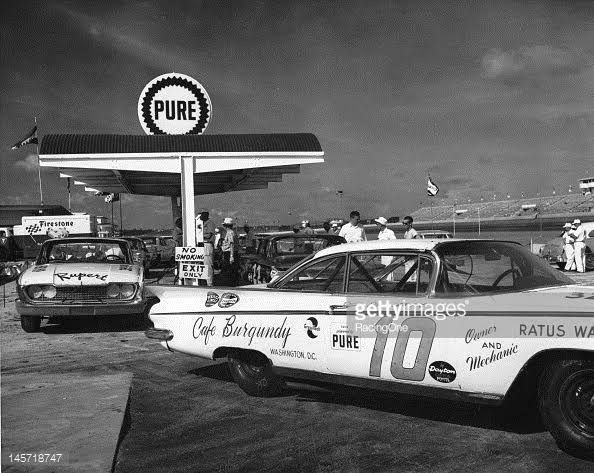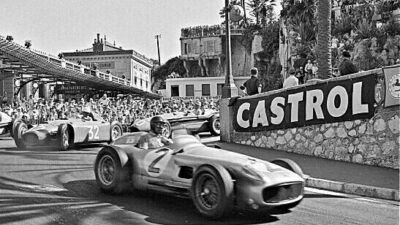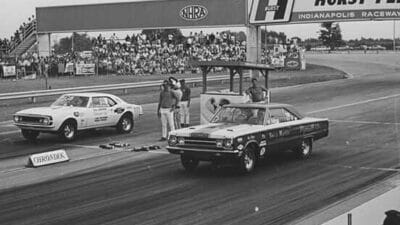Most drivers know regular pump gas gets their car from point A to point B, but racing fuel operates in a completely different league. Racing fuel contains higher octane ratings, specialized chemical compositions, and additives designed specifically for high-performance engines that operate under extreme conditions. While pump gas typically ranges from 87 to 94 octane, race fuels can reach octane levels from 95 up to 118.

The differences go far beyond just octane numbers. Racing fuel is engineered for engines that run at high RPMs for extended periods, generating extreme heat and pressure that would break down regular gasoline. These specialized fuels resist knock and pre-ignition while maintaining stable combustion under racing conditions.
Understanding when and why to choose racing fuel over pump gas can mean the difference between peak performance and engine damage. The choice depends on factors like compression ratio, boost levels, and intended use, making fuel selection as important as choosing the right camshaft for an engine build.
Key Takeaways
- Racing fuel offers significantly higher octane ratings and specialized additives compared to standard pump gasoline
- High-performance engines benefit from racing fuel’s ability to resist knock and maintain stable combustion under extreme conditions
- Proper fuel selection based on engine specifications and intended use is crucial for maximizing performance and preventing damage
Fundamental Differences Between Racing Fuel and Pump Gas
Racing fuel and pump gas serve completely different purposes, with distinct formulations and regulatory requirements. The octane ratings between street gas and race gas vary dramatically, while their intended applications and fuel standards differ significantly.
Purpose and Intended Applications
Pump gas is designed for everyday driving conditions and standard passenger vehicles. It must work reliably across various temperatures, altitudes, and driving situations.
Most street cars use compression ratios between 8:1 to 11:1. Pump gas handles these moderate performance demands without issues.
Racing fuel targets high-performance engines operating under extreme conditions. These engines often run higher compression ratios, forced induction, or aggressive timing maps.
Racing fuel is specially formulated for competitive motorsports and high-output engines. It provides consistent performance when engines face sustained high RPMs and extreme heat.
Key Application Differences:
- Pump Gas: Daily driving, varying weather, altitude changes
- Racing Fuel: Track use, consistent conditions, maximum performance
Racing applications demand fuels that resist detonation under severe stress. Street applications prioritize reliability and emissions compliance over peak performance.
Overview of Fuel Formulation
The most obvious difference lies in octane ratings. Most street gas ranges from 87 to 94 octane, while racing fuels span from 95 to 118 octane.
Racing fuel formulations vary significantly based on specific needs. Some contain lead for valve seat protection in older engines. Others use ethanol blends for higher octane ratings.
Formulation Components:
| Component | Pump Gas | Racing Fuel |
|---|---|---|
| Octane Range | 87-94 | 95-118 |
| Lead Content | Unleaded only | Leaded or unleaded |
| Ethanol | Up to 10% | Variable percentages |
| Oxygen Content | 3.5-3.7% | Varies by blend |
Vapor pressure and boiling points differ between the two fuel types. Street gas adjusts for seasonal temperature changes and varying altitudes.
Racing fuel uses narrower distillation ranges since race cars operate in controlled conditions. This creates more predictable combustion characteristics.
Ethanol content affects energy density and oxygen levels in the fuel mixture. Higher ethanol concentrations require fuel system adjustments for proper air-fuel ratios.
Fuel Standards and Regulations
Pump gas must meet strict federal and state emissions standards. The Environmental Protection Agency regulates detergent packages, sulfur content, and vapor pressure limits.
California and other CARB states require special formulations. These regulations focus on reducing smog formation and protecting catalytic converters.
Racing fuel faces different regulatory requirements. Many racing fuels cannot be used on public roads due to emissions equipment compatibility.
Regulatory Categories:
- Street Legal Racing Fuel: Meets emissions standards, won’t damage catalytic converters
- Competition Only: Higher performance, not street legal
Sanctioning bodies often restrict fuel choices in competitive racing. Some require unleaded fuels regardless of emissions equipment presence.
Street-legal racing fuels like SS100 and 260 GT maintain emissions compliance while offering higher octane ratings. These bridge the gap between pump gas and competition fuels.
Quality standards also differ significantly. Racing fuel maintains tighter specifications for consistency across batches. Pump gas allows more variation while meeting minimum performance requirements.
Octane Rating and Engine Performance
The octane rating determines how well fuel resists premature ignition under compression and heat. This measurement directly affects ignition timing, compression ratios, and engine protection in high-performance applications.
Understanding Octane Rating: AKI, RON, and MON
Regular pump gas ranges from 87 to 94 octane, while racing fuel extends from 95 to 118 octane. The number displayed on fuel pumps represents the Anti-Knock Index (AKI).
AKI calculates the average of two separate measurements. The formula uses Research Octane Number (RON) plus Motor Octane Number (MON), then divides by two.
RON measures fuel resistance under mild engine conditions at 600 RPM. MON tests the same fuel under more severe conditions at 900 RPM with higher temperatures.
The AKI system provides a balanced rating that reflects real-world driving conditions. Racing applications often reference RON numbers, which typically run 4-6 points higher than AKI ratings.
Laboratory engines determine both RON and MON values through standardized testing procedures. These controlled tests ensure consistent fuel ratings across different brands and suppliers.
Impact on Ignition Timing and Compression Ratio
Higher octane fuel allows engines to run more aggressive ignition timing without knocking. This timing advance increases power output and thermal efficiency in properly tuned engines.
Compression ratios above 10:1 typically require premium fuel with 91+ octane. Racing engines with 12:1 or higher compression ratios need fuel rated 100+ octane for safe operation.
Forced induction engines benefit from higher octane through increased boost pressure and advanced timing maps. Turbo and supercharged engines generate additional heat and pressure that demands superior knock resistance.
Engine computers automatically retard timing when knock sensors detect detonation. This protection reduces power output and can limit boost pressure in turbocharged applications.
Proper fuel selection allows tuners to optimize ignition curves for maximum performance. Each octane level supports specific timing advances before reaching the knock threshold.
Detonation Resistance and Engine Protection
Detonation occurs when fuel ignites from compression and heat before the spark plug fires. This uncontrolled combustion creates damaging pressure spikes and extreme temperatures.
Engine damage from sustained detonation includes:
- Piston crown cracking
- Ring land failure
- Head gasket deterioration
- Bearing damage from shock loads
Higher octane prevents pre-ignition and knocking by maintaining stable combustion characteristics under pressure. The fuel molecules resist spontaneous ignition until the spark plug initiates the burn.
Racing engines operate under extreme conditions that amplify detonation risks. High RPM, sustained load, and elevated temperatures all increase the likelihood of knock events.
Modern engine management systems pull timing and reduce boost when knock occurs. However, track conditions often push engines beyond normal parameters where premium fuel provides essential protection margins.
Chemical Composition and Additives
Racing fuel contains carefully engineered hydrocarbon blends with specialized additives that differ significantly from standard gasoline. These specialized chemicals prevent pre-ignition and allow for more efficient burning compared to regular fuel formulations.
Hydrocarbon Base Structures
Racing fuels use refined hydrocarbon chains optimized for high-performance combustion. Unlike pump gas that contains a wide mixture of hydrocarbons, race fuel features more uniform molecular structures.
The base hydrocarbons in racing fuel typically have shorter, more consistent carbon chains. This creates more predictable burning characteristics under extreme engine conditions.
Key differences include:
- More uniform molecular weight distribution
- Higher concentration of branched hydrocarbons
- Reduced sulfur content for cleaner combustion
- Tighter distillation ranges for consistent vaporization
These controlled hydrocarbon structures allow engines to run higher compression ratios without knocking. The uniform composition also provides more consistent power delivery across different temperature conditions.
Role of Aromatics and Oxygenates
Aromatics and oxygenates boost octane ratings and improve combustion efficiency in racing applications. These compounds burn differently than straight hydrocarbons, creating specific performance advantages.
Ethanol serves as a common oxygenate in racing fuel. It increases octane ratings naturally while adding oxygen to the fuel mixture. However, ethanol is less energy dense than gasoline and will require richening up fuel mixtures at higher concentrations.
Racing fuels may contain 10-85% ethanol depending on the application:
| Ethanol Content | Octane Boost | Fuel System Changes Required |
|---|---|---|
| 10-15% | Moderate | Minimal |
| 50-85% | High | Significant |
Aromatics like toluene and xylene provide octane enhancement without oxygen content. These compounds allow precise tuning of fuel characteristics for specific engine requirements.
Additives for Engine Protection
Racing fuel contains specialized additives designed for extreme operating conditions. These compounds protect engines from the stress of high RPM and temperature operation.
Anti-knock compounds prevent premature ignition under high compression. Metal deactivators stop catalytic reactions that could cause fuel degradation during storage.
Common racing fuel additives include:
- Antioxidants to prevent gum formation
- Static dissipator additives for fuel handling safety
- Corrosion inhibitors for fuel system protection
- Thermal stability improvers for high-temperature operation
Lead additives appear in some racing fuels for octane enhancement and valve seat protection. However, many sanctioning bodies require unleaded fuel even without emissions equipment requirements.
These additives work together to maintain fuel quality under racing conditions. They prevent engine damage while maximizing performance potential.
Energy Content and Combustion Characteristics
Racing fuel and pump gas differ significantly in their energy density and how they burn in high-performance engines. These differences directly impact power output and fuel consumption in racing applications.
Energy Density Comparison
Racing fuel typically contains less energy per gallon than regular pump gas. This happens because many racing fuels include ethanol or other oxygenated compounds that reduce the overall energy density.
Ethanol is less energy dense than gasoline, so engines using ethanol-blended racing fuels will consume more fuel to produce the same power output. Pure gasoline contains approximately 115,000 BTUs per gallon, while E85 racing fuel contains only about 83,000 BTUs per gallon.
The trade-off comes in performance benefits. While racing fuel may have lower energy content, it allows engines to run higher compression ratios and more aggressive timing without knocking. This means engines can extract more power from each combustion cycle.
Racing fuel’s consistent formulation also matters. Unlike pump gas that varies by season and location, racing fuel maintains stable energy content. This consistency helps racers tune their engines precisely for maximum performance.
Combustion Efficiency in High-Performance Engines
Racing fuels burn faster and more completely than pump gas. Burning rate is the speed at which fuel burns and releases heat energy, and racing fuels are designed for rapid combustion at high RPMs.
High-performance engines have less time for complete combustion at racing RPMs. Racing fuel’s faster burn rate ensures more complete fuel consumption during the short combustion window. This reduces wasted fuel and increases power output.
Oxygenated racing fuels improve combustion efficiency. Many race fuels are oxygenated, adding oxygen compounds to help improve combustion efficiency and power output. The extra oxygen creates more complete burning of the fuel mixture.
This improved combustion produces more power from naturally aspirated engines. However, it also means engines consume fuel faster because they’re burning the additional oxygen along with the fuel.
Ethanol Content: Pump vs Racing Fuels
Ethanol percentages vary significantly between pump gas and racing fuels, with pump E85 containing 51-83% ethanol while racing E85 maintains consistent 85% levels. These differences affect engine performance, cold-weather starting, and fuel mixture requirements.
Ethanol Proportion in Common Fuels
Regular pump gas typically contains up to 10% ethanol as an oxygenate additive. This ethanol content burns like street gas at these lower concentrations.
Pump E85 ranges from 65% to 85% ethanol based on federal regulations. Some states like Illinois and Wisconsin require 80-85% ethanol content with minimum 91 octane ratings.
Racing E85 maintains more consistent ethanol levels. Racing Pro E85 blends at exactly 85% ethanol regardless of season. This consistency provides better tuning predictability for race engines.
The gasoline portion also differs between fuel types. Racing E85 uses premium alkylate instead of low-grade gasoline or refinery byproducts found in pump versions.
Impact on Cold-Start and Seasonal Variations
Cold weather creates starting challenges with high ethanol content. Passenger cars struggle to start on pure ethanol in cold climates, requiring gasoline blending for proper vaporization.
E85 gets blended down to E70 in cold weather as gasoline content increases for better starting and drivability. The gasoline percentage fluctuates between 15% and 30% based on seasonal requirements.
Racing fuels avoid these seasonal variations by maintaining consistent ethanol percentages year-round. This stability eliminates the need for engine retuning based on fuel composition changes.
Ethanol absorbs water from air humidity, which can cause corrosion issues. Racing fuels address this through controlled storage and handling procedures.
Selecting the Right Fuel for Racing Applications
Choosing the wrong fuel can cost power and damage expensive racing engines. Different racing applications require specific fuel formulations based on engine design, competition rules, and performance goals.
Tailoring Fuel Choice to Engine Requirements
High-compression naturally aspirated engines need fuels with octane ratings between 98 and 110. These engines compress the air-fuel mixture more than street engines, creating higher temperatures and pressures that can cause knock.
Turbocharged and supercharged engines require even higher octane levels. Forced induction engines benefit from octane ratings of 110 to 118 to handle increased boost pressures and intake temperatures.
Key Engine Considerations:
- Compression ratio: Higher ratios need higher octane
- Forced induction: Turbo/supercharged engines require premium race fuels
- Ignition timing: Aggressive timing demands knock-resistant fuel
- Operating temperature: Hot conditions increase octane requirements
Drag racing engines often use different fuels than endurance racing engines. Short-duration events allow for more aggressive fuel mixtures that might not be suitable for long races.
Modern fuel injection systems can adjust for different fuel types. However, switching from pump gas to race fuel may require ECU tuning to optimize timing and fuel delivery.
Risks of Using Pump Gas in Racing Engines
Pump gas contains detergents and additives designed for street driving, not racing conditions. These additives can create deposits in high-performance engines operating at extreme temperatures and RPMs.
Primary Risk Factors:
- Detonation damage: Low octane causes knock that destroys pistons and bearings
- Power loss: ECUs reduce timing and boost to prevent knock
- Fuel system issues: Pump gas can vaporize in high-temperature fuel lines
- Inconsistent quality: Seasonal blends vary in octane and volatility
Racing engines run much hotter than street engines. Pump gas can vapor lock in fuel lines or cause lean conditions that lead to engine damage.
The ethanol content in pump gas absorbs moisture from the air. This water can cause corrosion in fuel systems and inconsistent combustion in racing applications.
High-performance engines with aftermarket ECU tuning often cannot compensate for pump gas limitations. The result is reduced power output and potential engine damage from uncontrolled detonation.
Legal and Regulatory Considerations
Most racing sanctioning bodies have strict fuel regulations. NASCAR, NHRA, and other major series specify approved fuel suppliers and octane ratings for different classes.
California and other CARB states require specific unleaded race fuels like SS100 for street-legal vehicles used in competition. Non-CARB states typically allow 260 GT fuel for similar applications.
Regulatory Requirements:
- Unleaded mandates: Most series ban leaded fuels
- Oxygenate limits: Ethanol content restrictions vary by class
- Fuel sampling: Officials test fuel for compliance at events
- Storage regulations: Race fuel storage follows hazmat guidelines
Vintage racing often allows leaded fuels to protect older engines with soft valve seats. However, many tracks and sanctioning bodies are moving toward unleaded-only policies.
Street cars used for track days must comply with emissions equipment requirements. Catalytic converters and oxygen sensors require unleaded fuels to function properly.
Import regulations affect fuel availability in different regions. Some high-octane racing fuels available in Europe may not meet US specifications or vice versa.
Frequently Asked Questions
Racing fuel differs from pump gas mainly through octane ratings that range from 100-120 compared to 87-93 for regular gasoline. The chemical makeup, additives, and ethanol content also vary significantly between these fuel types.
What is the typical octane rating for racing fuel compared to regular pump gas?
Regular gasoline at gas stations ranges from 87 to 93 octane. Most street gas uses the AKI (Anti-Knock Index) rating system.
Racing fuel ranges from 100 to 120 octane. Some specialty racing fuels can reach up to 118 octane rating.
Anything over 93 octane sold at the pump is usually considered racing fuel. Most often, racing fuel starts at 100 octane and goes higher.
How does the chemical composition of racing fuel differ from standard gasoline?
Race fuels are typically cleaner and more consistent than pump fuels. The manufacturing process focuses on performance rather than cost.
Racing fuels contain different hydrocarbon blends designed for specific engine requirements. The distillation curves are narrower than pump gas because race cars operate in more controlled conditions.
Some racing fuels still contain lead additives for valve seat lubrication. Modern racing fuels may also include specialized detergent packages for engine protection.
Is there a difference in energy content between racing fuel and conventional pump gas?
Octane rating does not measure the energy content in fuel. Higher octane fuel does not burn hotter or create more power by itself.
The energy content varies based on the specific blend and additives used. Ethanol-blended racing fuels have less energy density than pure gasoline.
Racing fuels with oxygen carriers like ethanol provide more available oxygen for combustion. This can result in more power output but requires more fuel consumption.
What additives are commonly found in racing fuel that are not in regular gasoline?
Some racing fuels contain lead additives that have been banned from pump gas since the 1970s. Lead helps lubricate valve seats in older engines.
Racing fuels may include specialized detergent packages for engine cleaning. These additives help remove carbon deposits and maintain engine performance.
Oxygenates like ethanol are used in racing fuels to increase octane ratings. These additives also provide additional oxygen for more complete combustion.
How does the presence of ethanol in fuel vary between race fuel and pump gas?
Pump gas typically contains up to 10% ethanol in most areas. This ethanol content is regulated by government standards for emissions and fuel economy.
Racing fuels offer more variety in ethanol content. Some contain no ethanol while others have higher concentrations for increased octane.
Higher ethanol concentrations require fuel mixture adjustments. Engines need richer fuel mixtures because ethanol burns leaner than gasoline.
What factors contribute to the price difference between racing fuel and pump gasoline?
Racing fuels cost more due to specialized manufacturing processes. The production volumes are much smaller than regular gasoline.
Quality control standards are higher for racing fuels. More testing and consistency checks add to the manufacturing costs.
Distribution networks for racing fuel are limited compared to pump gas. This specialized distribution system increases the final price to consumers.










